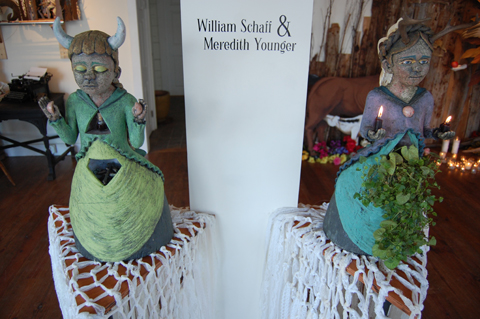
RELIQUARIES Younger's 'Moloch and Artemis.' |
“In our culture in general, we have all these twisted ideas of how you’re supposed to deal with death,” Meredith Younger said when I visited “Bearing Witness,” a poignant art installation and a shrine to the dead — a friend, an aborted baby — by the Providence artist and her collaborator here, William Schaff of Warren, at 186 Carpenter (186 Carpenter St, Providence, through January 30). It’s one of the best shows of the year.
The roots of the exhibition are revealed in a binder on a table near the door. Inside is a March police report from Indianapolis recounting officers called to investigate a report of 39-year-old man “found deceased inside.”
“He was a musician, but he drank himself to death, sadly,” Schaff says of his friend. “An incredible musician.”
The binder also includes a copy of Younger’s form from a Providence clinic for a “medicated abortion” last spring.
“I was supposed to go home and take these pills and flush it all away,” Younger says. “So I collected the blood and thought about it.
“I feel totally comfortable in the choice,” she adds. “The sadness in the piece is for me not the decision itself. The partner, the father, is somebody I really love. It’s just a shame that it wasn’t the right time. I already have a 14-year-old and I’m adopted, so I feel like I can talk about it from all sides.”
Twin child-faced ceramic goddesses by Younger stand at the center of the gallery. They serve as reliquaries for blood from the abortion. Moloch has horns and closes her eyes as she holds up a broken sphere. A fire burns in a lamp in her pelvis. Younger says it’s about “what you sacrifice to meet your own ends.” To the right, Artemis has antlers atop her head. Her eyes are open and she holds lit candles in her hands. A green leafy plant sprouts from her belly. “Everything is made whole in her,” Younger says.
Along the wall at the left is a Schaff screenprint of two skull-headed figures stabbing each other in the gut with a banner that reads, “With much wisdom comes much sorrow — the more knowledge, the more grief.” Two studio desks are filled with drawings and skulls. An old typewriter sits on Younger’s desk with a sheet of paper in it which reads, “What can I say without first touching the earth with my hands? — Pablo Neruda.”